cell membrane
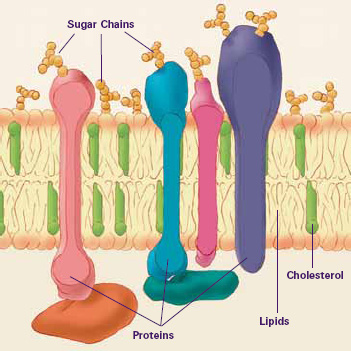
Figure 1. Cell membrane cross section. Image: National Institute of General Medical Sciences.
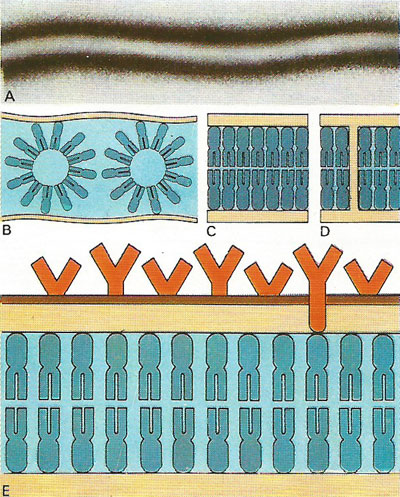
Figure 2. The cell membrane (A), magnified 2 million times, appears layered. Models of the membrane show fat globules (B), fat layers (C, E), and a protein channel (D).
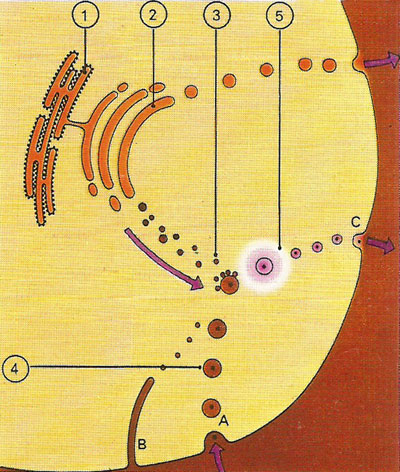
Figure 3. Large particles can enter the cell via an infolding of the membrane (A, B). These vesicles (4) fuse with lysosomes (3) containing digestive enzymes. Digestive products (5) are absorbed and waste products are ejected (C). Materials made by the endoplasmic reticulum (1) may leave via the Golgi body (2).

Figure 4. Molecules may enter cells in different ways depending on the environment that exists with the cell and outside it. Transfer of molecules (1) may occur by diffusion when their concentration is higher outside the cell membrane (2) than it is inside it. This is a passive process and continues until the concentrations are equal on each side of the membrane. Molecules move into the cells of the alimentary tract by diffusion during the digestive process.
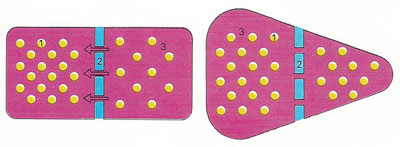
Figure 5. Many large molecules such as proteins (1) are permanently enclosed by the cell membrane (2). The more concentrated they become the more they attract water (3). This water movement is called osmosis.
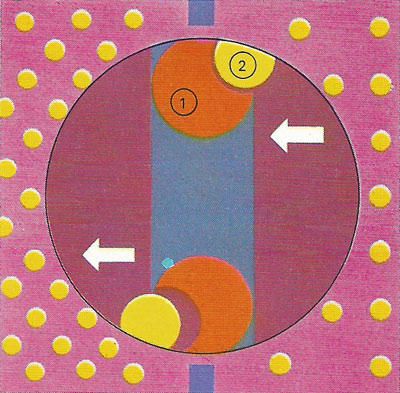
Figure 6. Cells can take in molecules from low to high concentrations b y active transport requiring energy. Carrier molecules (1) in the membrane bind to the incoming molecules (2) on one side of the membranes and release them on the other.
A cell membrane is any membrane found in a living cell. However, unless otherwise specified (see below), it normally refers to the plasma membrane that surrounds the cytoplasm of a cell and forms the cell boundary.
The cell membrane consists of a lipid bilayer with embedded proteins. Depending on the membrane's location and role in the body, lipids can make up anywhere from 20 to 80 percent of the membrane, with the remainder being proteins. Lipids generally give membranes their flexibility. Cholesterol is a type of lipid that, by contrast, helps stiffen the membrane of animal cells but is not found in plant cells.
The cell membrane regulates what enters and leaves the cell, maintains the correct intracellular pH level, and provides a means of separating charges so that the cell can, for example, generate the energy-carrying molecule adenosine triphosphate. Proteins transmit chemical messages into the cell, and they also monitor and maintain the cell's chemical climate. On the outside of cell membranes, attached to some of the proteins and lipids, are chains of sugar molecules that help each cell type do its job.
The cell membrane is both a physical and chemical barrier which defines the boundary between the individual and its environment. Its origin is intimately connected with the origin of life as we know it.
Movement of across the membrane
The movement of various types and sizes of substances across the cell membrane is illustrated in Figures 3 to 6.
Quick facts
Other cell membranes
Other membranes found inside cells include the nuclear envelope, which surrounds the cell nucleus, the tonoplast, which encloses the vacuole of plant cells, and the membranes of the various cell organelles, such as the mitochondria, endoplasmic reticulum, lysosomes, and chloroplasts.
Origin of cell membranes
Cell membrane formation was a crucial stage in the evolution of terrestrial life. However, whether the first self-replicating life-forms on Earth possessed a membrane or whether they were merely naked strands of nucleic acid is as yet undetermined. Even if the earliest organisms did possess a membrane of some sort, it was probably not of their own making. The likelihood is that ready-made receptacles were to hand which they could have used. Such receptacles may form in interstellar space on the surface of cosmic dust grains. At least two pieces of evidence support this view: (1) the discovery of what appear to be two-layered vesicles in material extracted from the Murchison meteorite; and (2) the synthesis of similar microscopic structures on Earth in experiments designed to replicate conditions within interstellar clouds of gas and dust.


